Predictions abound as 2022 kicks off and retail trends are not immune to speculation. The Covid pandemic continues to loom over retail but very differently from its impact in both 2020 and 2021. 2020 saw closures and bankruptcies, while many retailers were buoyed in 2021 – with bankruptcies down and plans for expansion.
One of the biggest takeaways from the last two years is the need to bolster supply chains, across industries. Retail Dive: Retail News and Trends notes supply chain resilience as one of the top 10 trends to watch in 2022. We’ve learned, grown, changed, and seen many shifts over the past two years, and the trends to watch this year certainly reflect that. From redefining employee benefits to balancing wholesale and DTC offerings, here’s where we see brands having work to do in 2022 to remain competitive.
BUOYING THE SUPPLY CHAIN
Supply chain woes hit throughout industries, but most notably those sourcing from overseas. Shipping slowdowns and port back-ups left cargo ships, and their containers, stranded at sea for incredible lengths of time. Some brands took to engaging private charters to make sure their shipments arrived, but the stranded cargo ships also caused a shortage of containers around the globe.
Brands began to look closer to home, with some opting to dual source inventory, utilizing domestic manufacturers to close the gap until overseas orders could arrive. Mattel was one big name that adopted this strategy heading into the holiday shopping season. With toys sitting in cargo ships at sea or waiting to be unloaded at port, there were certainly concerns about store shelves and having them stocked with the season’s most popular offerings.
Building off the supply chain pivots and adjustments made in the past two years, we see a need for continued investments in the supply chain – including adding domestic manufacturing to many retailer strategies. Supply chains have been designed for predictability in buying cycles and consumer expectations and were completely unprepared for the disruptions that the industry faced. Additionally, rising environmental and social risks continue to show that now is the time for supply chain reinvention.
LABOR CRUNCH CONTINUES
A plethora of job opportunities across industries has led to an extremely tight labor market. Workers who are dissatisfied in their current employment situations are willing and able to leave for bigger and better opportunities. Team members are no longer satisfied with a “take whatever they can get” mentality and are looking for improved offerings from their employers. And across many industries, employers are adapting to meet those needs – offering flexible scheduling, increasing benefits packages, and of course, making compensation changes.
Retailers from grocers to apparel will need to do the same. Following a model like Costco could benefit many organizations, as they prioritize their team members – both full time and part time. Offering competitive wages and benefits to all of their employees is part of why Costco is continually rated as a top place to work. With so many open and available jobs on the market right now, focusing on retention should be a top priority for retailers in 2022.
BRICK-AND-MORTAR MAINTAINS CONSUMER HOLD
E-commerce has seen exceptional growth over the past two decades, and the early days of the pandemic certainly further fed into our reliance on e-commerce. But the numbers show that although e-commerce sales will exceed $1 trillion in 2021, 84% of retail sales are still coming from physical stores. We’ve written on the topic before and will continue to talk about it. Consumers crave the shopping experience, for both the tactile ability to see and touch an item before purchasing it and the social aspect of shopping as a pastime. Connecting with a purchase in person continues to lead consumers into stores, especially with fitting rooms reopened. Virtual reality experiences for trying on clothes may have helped fill some gaps over the past two years, but the true experience of trying on a piece of clothing in person cannot be minimized.
Technological integration will also be key to the success of physical stores, as consumers continue to price check and review inventory from their phones while in-store. We saw some retailers, like Lowes and Walmart, lean into this in 2021 with their apps. Offering store maps that assist shoppers in locating goods throughout the store and confirming inventory levels before a consumer even leaves their home. Low to no touch options for reviewing product information before even touching the product could be on the horizon as well. 2020/2021 brought the QR code back into prominence and we should expect the impact of this type of option to continue.
The NRF expects that we will continue to see new store concepts, like the multiple options recently rolled out by Dick’s Sporting Goods to serve a varied consumer base, rolling out across retail segments. Large scale investments in independent locations like Dick’s is doing may not be possible for some retailers that want to create an experiential location but without the footprint. Some brands will accomplish this through store-in-a-store concepts and we currently see this playing out through the Toys-R-Us partnership with Macy’s. Dollar General has followed suit with its investment in its pOpshelf concept inside of hundreds of stores to cater to wealthier clientele.
WHAT DOES IT ALL MEAN?
Retail will continue to change and evolve in 2022 – learning from the past two years of disruption and working towards meeting consumer needs in the best way possible. Investments in technology, new store concepts (both freestanding and store-in-a-store), and fixtures that make consumers comfortable and excited to return to physical stores will be a hallmark of the year to come. Are you ready?




